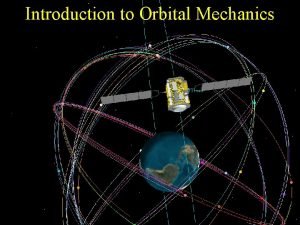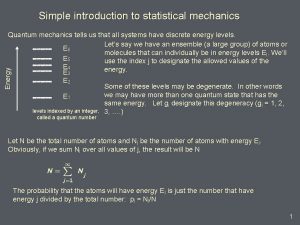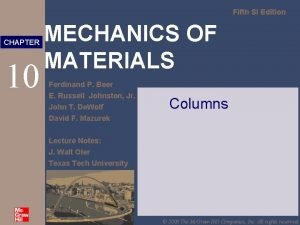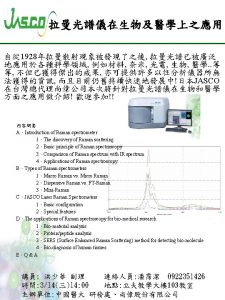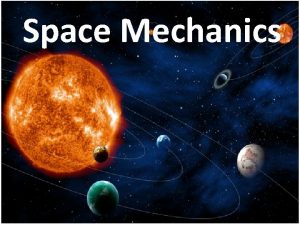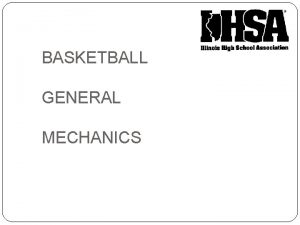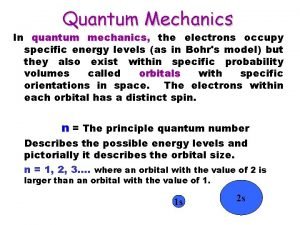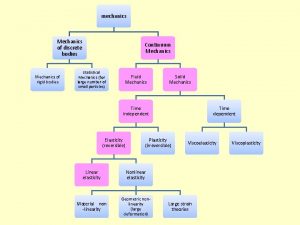Chapter 4 AIntroduction to Mechanics Introduction to Mechanics











- Slides: 11

Chapter 4 AIntroduction to Mechanics

Introduction to Mechanics • Mechanical (physics) explanations mean that God has made principles to govern the nonliving matter in His creation. • The study of motion is called mechanics • Based on Newton’s 3 laws of motion • Today split into 3 parts: • Kinematics • Description of how things move • Dynamics • Description of what causes things to move • Statics • Description of how stationary things react to pushes and pulls

Introduction to Mechanics • Physical Systems • A system is what you are studying, separated from the rest of the universe by a real, or imaginary, boundary • Everything inside is important • Everything outside is the surroundings

Frames of Reference • The motion you observe from your point of view is your frame of reference • It is the stationary place from which we make our observations • Kinds of reference frames: • Fixed- the system moves in a straight line, you don’t • Watching a car speed past you • Accelerated- you move with the system • Being inside a speeding car • Rotational- the rotating object is stationary, you aren’t • Being on a merry-go-round looking in

Coordinate Axis

Coordinate Axis

Coordinate Axis -5 m 0 m 5 m • Use a straight x-axis: coordinate axis • The origin has a value of zero. • We can say x=0 • So how far did the car move? • 20 m 10 m 15 m 20 m

Time Intervals • What is a time interval? • First, what is an interval? • The length something from start to finish • Time interval is from the start of the time (ti) to when it finished (tf) • We use a delta (Δ) to talk about intervals/ change(time, distance, energy, etc) • Time interval: Δt This time interval: ti=0 s tf= 10 s Δt= 10 s

Scalars and Vectors • A scalar is any measurable quantity that can be completely described with a single piece of information. • Can be +, -, or 0 • Examples: • 355 m. L (soft drink can), 23°C (temperature outside), 1: 50 pm (time of day) Scalar = “How much” • Vectors- have a scalar value and a direction • Shown with an arrow • Length of arrow shows size of scalar • Examples: Vector = “How much? ” and “Which way? ”

Scalars and Vectors are very important in forces. Vectors provides how much force is being applied but also in which direction. force Force (F) weight (w) Velocity (v) weight (w)

Vocabulary • Mechanics • Kinematics • Dynamics • Statics • System • Surroundings • Frame of Reference • Coordinate axis • Interval • Scalar • Vector
 Orbital inclination formula
Orbital inclination formula Introduction to quantum statistical mechanics
Introduction to quantum statistical mechanics Chapter 6 safety and body mechanics
Chapter 6 safety and body mechanics Fluid kinematics
Fluid kinematics Mechanics of materials 7th edition solutions chapter 10
Mechanics of materials 7th edition solutions chapter 10 Mechanics of materials chapter 9
Mechanics of materials chapter 9 Chapter 7 beer
Chapter 7 beer Mechanics of materials chapter 6
Mechanics of materials chapter 6 Mechanics of materials chapter 5 solutions
Mechanics of materials chapter 5 solutions Beer johnston
Beer johnston Mechanics of materials chapter 3 solutions
Mechanics of materials chapter 3 solutions Mechanics of materials 7th edition solutions chapter 10
Mechanics of materials 7th edition solutions chapter 10
